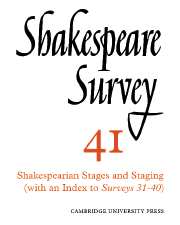Book contents
- Frontmatter
- The Shakespearian Stages, Forty Years On
- The Original Staging of The First Part of the Contention (1594)
- Charles Calvert’s Henry V
- Hamlet, An Apology for Actors, and The Sign of the Globe
- ‘Hid indeed within the centre’: The Hall/Finney Hamlet
- Malvolio and the Dark House
- The Text of Cressida and Every Ticklish Reader: Troilus and Cressida, The Greek Camp Scene
- Antony and Cleopatra, Act 4 Scene 16: ‘A Heavy Sight’
- The Tempest’s Tempest at Blackfriars
- Keats and Lucrece
- The Resources of Characterization in Othello
- Ovid and the Mature Tragedies: Metamorphosis in Othello and King Lear
- The Passing of King Lear
- Shakespeare Performances in London and Stratford-upon-Avon, 1986–7
- Professional Shakespeare Productions in the British Isles, January–December 1986
- The Year's Contributions to Shakespeare Studies: 1 Critical Studies
- 2 Shakespeare’s Life, Times, and Stage
- 3 Editions and Textual Studies
- Books Received
- Index to Volume 41
- General Index to Volumes 31-40
Malvolio and the Dark House
Published online by Cambridge University Press: 28 March 2007
- Frontmatter
- The Shakespearian Stages, Forty Years On
- The Original Staging of The First Part of the Contention (1594)
- Charles Calvert’s Henry V
- Hamlet, An Apology for Actors, and The Sign of the Globe
- ‘Hid indeed within the centre’: The Hall/Finney Hamlet
- Malvolio and the Dark House
- The Text of Cressida and Every Ticklish Reader: Troilus and Cressida, The Greek Camp Scene
- Antony and Cleopatra, Act 4 Scene 16: ‘A Heavy Sight’
- The Tempest’s Tempest at Blackfriars
- Keats and Lucrece
- The Resources of Characterization in Othello
- Ovid and the Mature Tragedies: Metamorphosis in Othello and King Lear
- The Passing of King Lear
- Shakespeare Performances in London and Stratford-upon-Avon, 1986–7
- Professional Shakespeare Productions in the British Isles, January–December 1986
- The Year's Contributions to Shakespeare Studies: 1 Critical Studies
- 2 Shakespeare’s Life, Times, and Stage
- 3 Editions and Textual Studies
- Books Received
- Index to Volume 41
- General Index to Volumes 31-40
Summary
In writing the comic episode of Malvolio's imprisonment, in the second scene of act four of Twelfth Night, Shakespeare created an action which is not altogether easy to transfer to the stage. In his own time, if we are to believe the direction in the Folio ('Maluolio within' (4.2.20.1)), it was performed with Malvolio entirely out of sight and speaking from the tiring house, possibly from behind one of the stage doors; Feste would have had the entire expanse of the platform stage on which to play his games of changing identities, and we might imagine that the actor would naturally have broadened his antics to retain contact with the audience. In an Elizabethan public theatre, action near the stage doors was well removed from most of the spectators.
Staged thus, the scene does establish an important visual point, in that it is a reversal of the 'box-tree' scene (2.5), during which Malvolio holds the prominent downstage position while the conspirators spy on him from concealment upstage. The comedy of this earlier scene, a theatrical chestnut, depends on our being able both to hear and to see Sir Toby, Sir Andrew, and Fabian as they watch their gull take the bait; their stealth and circumspection are preposterously inept, and as a result farcical stage business has quite rightly been a tradition of the scene in performance.
- Type
- Chapter
- Information
- Shakespeare Survey , pp. 55 - 62Publisher: Cambridge University PressPrint publication year: 1989
- 1
- Cited by

